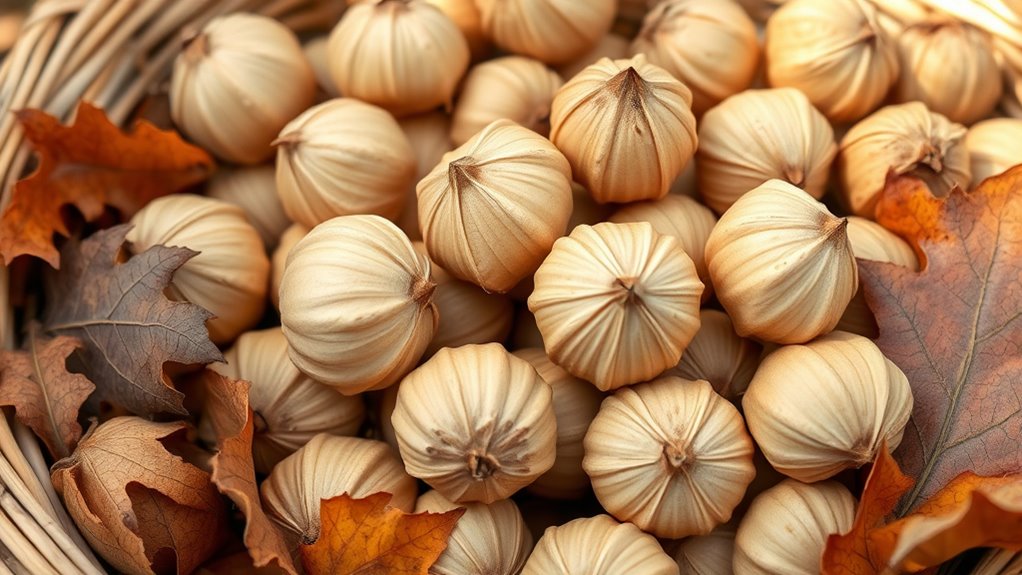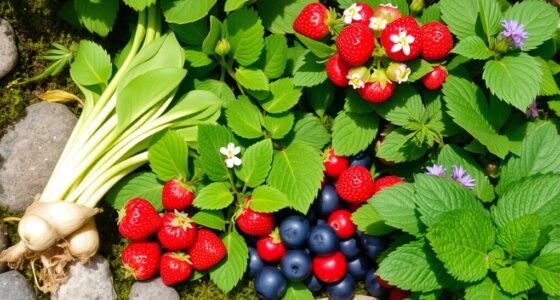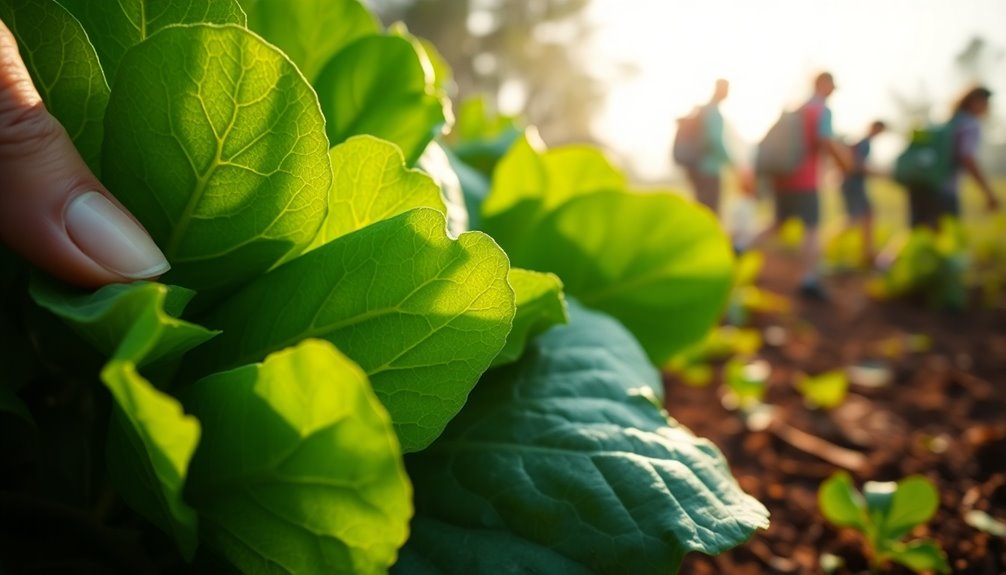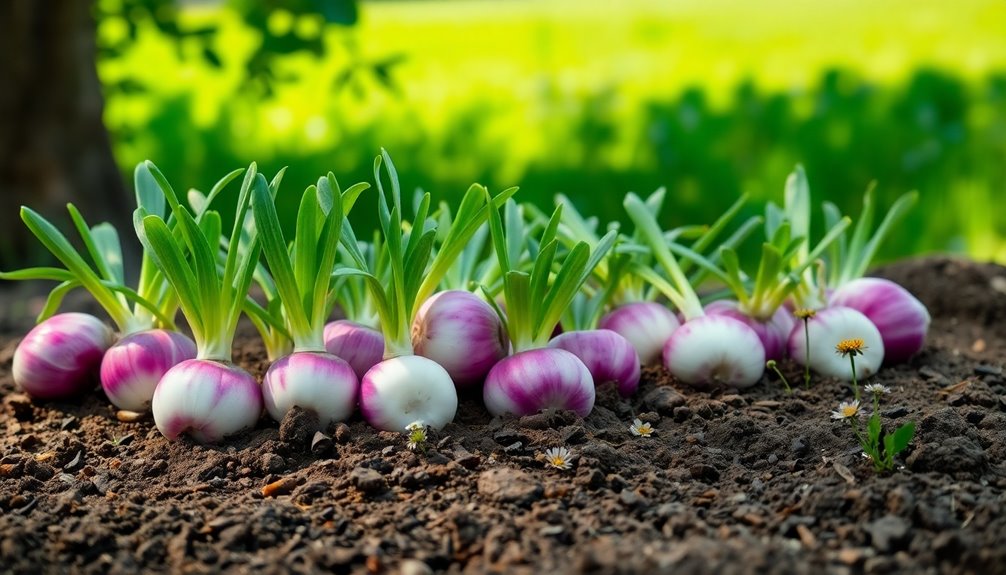To process beech nuts safely and reduce tannins, start by harvesting mature, healthy nuts when they naturally fall to the ground. Soak the nuts in water for several hours or overnight, changing the water periodically to draw out bitterness. Dry them thoroughly and then roast to enhance flavor and further decrease tannins. Handling nuts gently and selecting quality guarantees safer consumption. Keep exploring these steps to master natural, self-sufficient ways to enjoy beech nuts comfortably.
Key Takeaways
- Properly identify mature, healthy nuts by their color, plumpness, and natural fall to ensure safety and quality.
- Soak beech nuts in water overnight, changing water periodically, to effectively reduce tannin levels and bitterness.
- Handle nuts gently during harvesting to prevent damage and avoid contamination from mold or pests.
- Roast nuts carefully after soaking to enhance flavor and further diminish tannin content without overdoing it.
- Embrace natural processing techniques to maintain control over food quality, promote self-sufficiency, and reconnect with the natural bounty.
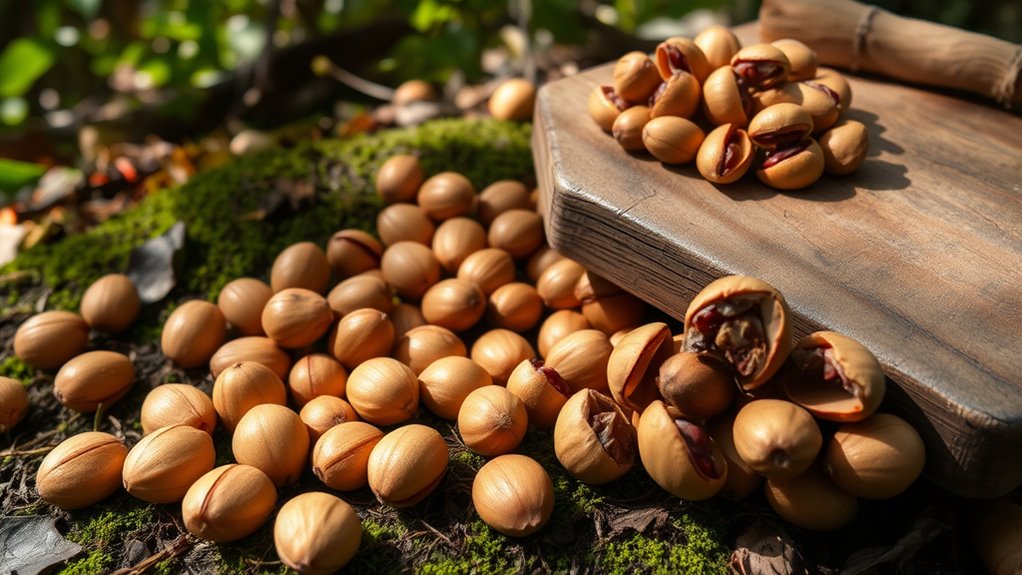
Beech nuts, the small edible seeds produced by beech trees, have been valued for centuries as a source of food and fuel. But if you’re seeking true liberation from dependence on industrialized food systems, you’ll want to understand how to harvest and process these nuts safely. Nut harvesting isn’t just about gathering; it’s about respecting the plant’s natural cycle and ensuring your efforts lead to nourishing results. When collecting beech nuts, look for those that are mature—typically brown, plump, and falling naturally to the ground. Avoid nuts that are shriveled, moldy, or have holes, as these could harbor mold or pests. Proper harvesting means timing your collection right, so you get the best flavor and nutritional value, free from unnecessary chemicals or additives. Being aware of potential small mistakes during processing can help prevent contamination and spoilage.
Once you have your nuts, it’s vital to consider the tannin content. Tannins are natural compounds that give beech nuts their bitter taste and can cause digestive discomfort if consumed in large quantities. Recognizing the importance of tannin levels is key to safe processing. You can reduce tannin content through soaking, which not only diminishes bitterness but also makes the nuts more digestible and edible. Submerge the nuts in water for several hours or overnight, changing the water periodically. This simple step strips away some of the tannins, freeing you from their unwanted grip and allowing you to enjoy the nuts without discomfort. Remember, the goal is to reclaim your power over your food sources, not to be bound by their natural defenses.
After soaking, you can dry the nuts thoroughly and then crack them open to access the nutmeat inside. Roasting can add flavor and further reduce tannins, but be mindful not to overdo it—prolonged heat can diminish nutrients. By taking these deliberate steps, you liberate yourself from reliance on processed foods and embrace a more natural, self-sufficient way of living. Processing beech nuts with awareness of tannin content isn’t just about taste; it’s about reclaiming control over what you consume and how it impacts your body. Nut harvesting in this way turns into a act of empowerment, transforming a simple seed into a symbol of independence. With patience and intention, you harness the power of nature’s bounty, stepping closer to genuine food sovereignty.
Frequently Asked Questions
How Long Does It Take to Process Beech Nuts Properly?
Processing beech nuts properly takes about 2 to 4 weeks, depending on your harvesting techniques and drying methods. You’ll start by gathering mature nuts and removing their husks, then dry them in a well-ventilated space. Regularly turning or shaking the nuts speeds up drying. Once fully dried and tannin-free, you can enjoy their nutty flavor. Patience is key to releasing their delicious, liberated potential.
Are Beech Nuts Safe for Children to Eat?
You can’t just give beech nuts to children without concern—they’re not automatically safe! Think of their tiny bodies as fragile as glass, easily overwhelmed by tannins or nut allergies. Prioritize child safety by ensuring proper processing and knowing about nut allergy awareness. Only serve beech nuts after thorough preparation and consultation with a healthcare professional. Don’t risk health hazards—take control, educate yourself, and confidently serve safe, delicious snacks to your kids!
Can Tannin Content Vary Between Different Beech Tree Species?
Yes, tannin levels can vary between different beech tree species due to species variation. You’ll find that some species naturally have higher tannin content, which can affect taste and safety. By understanding these differences, you can make informed choices and liberate yourself from uncertainty. Always research specific beech tree species before harvesting, and consider processing methods to reduce tannins, ensuring safe, enjoyable beech nut consumption.
What Are Common Signs of Tannin Poisoning?
You’ll notice tannin poisoning symptoms like nausea, vomiting, and abdominal pain shortly after ingestion. Tannin toxicity can also cause dizziness, headache, and a metallic taste in your mouth. If you experience these signs, it’s essential to seek medical help immediately. Recognizing poisoning symptoms early helps prevent serious health issues. Stay alert, trust your body’s signals, and avoid consuming raw or improperly processed beech nuts to protect yourself from tannin toxicity.
How Can I Tell if Beech Nuts Are Spoiled?
Like a warning whisper in the wind, spoiled beech nuts reveal themselves through a suspicious odor and visible mold growth. If they emit a foul smell or show signs of mold, toss them out without hesitation—your health’s worth the sacrifice. Don’t risk consuming nuts that have lost their significance. Trust your senses, and liberate yourself from the danger of spoiled food by inspecting carefully before indulging.
Conclusion
By now, you’re practically a beech nut expert, ready to conquer the wild with confidence! Just remember, mishandling these tiny treasures could turn your adventure into a tannin-tastrophe of epic proportions. With safe processing and tannin awareness, you’re unstoppable—like a nut-cracking superhero armed with knowledge. So go out there, gather those beech nuts, and enjoy nature’s bounty without a single worry. Your wild foraging journey just got a whole lot safer—and way more exciting!

